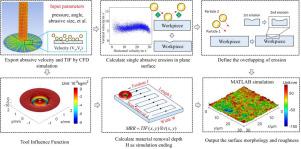International Journal of Mechanical Sciences ( IF 7.3 ) Pub Date : 2022-11-25 , DOI: 10.1016/j.ijmecsci.2022.107976 Zili Zhang, Chi Fai Cheung, Chunjin Wang, Jiang Guo

|
Fluid jet polishing (FJP) has been extensively used in various kinds of fields such as precision molding, optical components, etc. However, previous works mainly focused on the material removal process on the macro-scale (e.g., tool influence function, surface generation) to improve the form accuracy, the understanding of surface morphology evolution of FJP on the micro-scale is still far from complete, which makes it difficult to predict the surface quality under certain polishing conditions. Time-consuming and high-cost trial and error are usually needed to obtain suitable polishing conditions for specific surface quality requirements. In this paper, a physical model was developed to predict the surface morphology and roughness after FJP, by combining the computational fluid dynamics (CFD) simulation and kinetic analysis of the abrasives. The single abrasive erosion process including indentation action, ploughing action, and cutting action was analyzed by kinetic analysis. Besides, the overlap of single abrasive erosion pits was modeled to simulate the surface morphology evolution in FJP and determine the surface roughness after polishing. Different parameters were considered in the model including jet pressure, jet angle, and abrasive size. A series of polishing experiments were conducted to validate this model and the effect of different polishing parameters on surface quality was elucidated by the impact velocity distribution and erosion morphologies. It is found that the simulation results agree well with the experimental results. This paper not only provides a deeper understanding of the microscale material removal in FJP, but also provides an effective method for the prediction of surface roughness in FJP.
中文翻译:

流体喷射抛光中表面形态和粗糙度的建模
流体喷射抛光 (FJP) 已广泛应用于精密成型、光学元件等各种领域。然而,以前的工作主要集中在宏观尺度上的材料去除过程(例如,工具影响函数、表面生成) 为了提高形状精度,对微观尺度上 FJP 表面形貌演化的理解还远未完成,这使得在某些抛光条件下难以预测表面质量。通常需要耗时和高成本的反复试验才能获得适合特定表面质量要求的抛光条件。在本文中,通过结合计算流体动力学 (CFD) 模拟和磨料动力学分析,开发了一个物理模型来预测 FJP 后的表面形态和粗糙度。采用动力学分析方法分析了压痕作用、犁耕作用和切削作用等单一磨料侵蚀过程。此外,对单个磨料侵蚀坑的重叠进行建模,以模拟 FJP 中的表面形貌演变,并确定抛光后的表面粗糙度。模型中考虑了不同的参数,包括射流压力、射流角度和磨料尺寸。进行了一系列抛光实验来验证该模型,并通过冲击速度分布和侵蚀形态阐明了不同抛光参数对表面质量的影响。发现仿真结果与实验结果吻合较好。本文不仅提供了对 FJP 中微尺度材料去除的更深入理解,


























 京公网安备 11010802027423号
京公网安备 11010802027423号